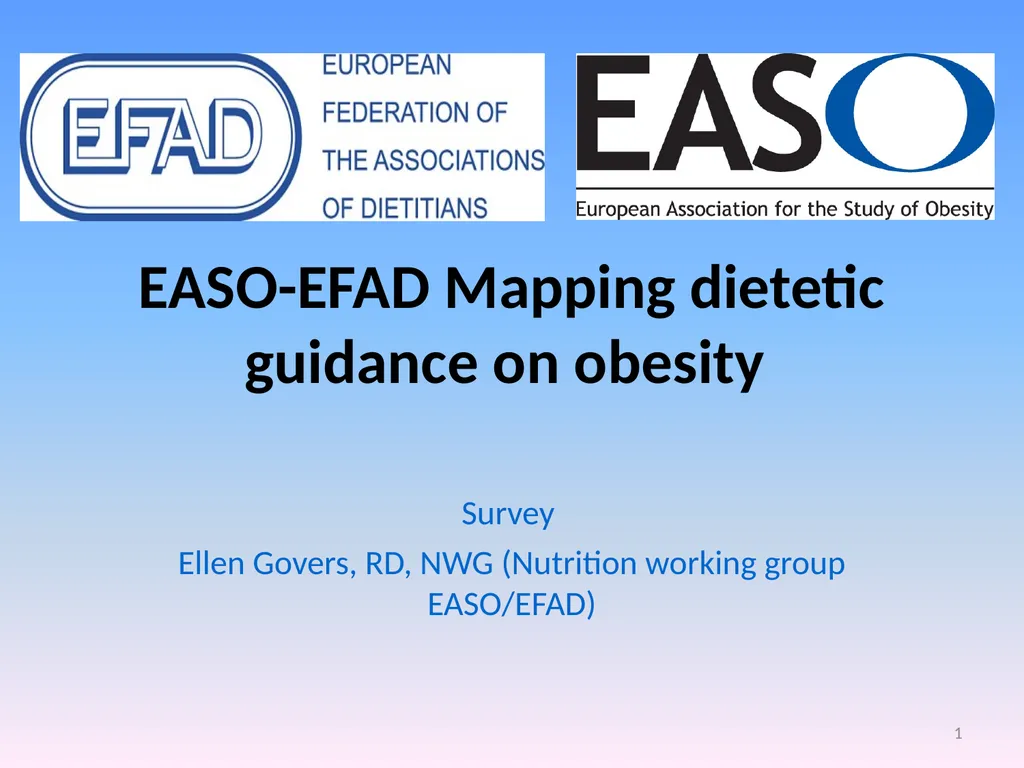EASO-EFAD Mapping dietetic guidance on obesity
Author : marina-yarberry | Published Date : 2025-05-13
Description: EASOEFAD Mapping dietetic guidance on obesity Survey Ellen Govers RD NWG Nutrition working group EASOEFAD 1 European Specialist Dietetic Network Obesity The ESDN Obesity has 6 members Maria Hassapidou Ellen Govers Tanja Callewaert
Presentation Embed Code
Download Presentation
Download
Presentation The PPT/PDF document
"EASO-EFAD Mapping dietetic guidance on obesity" is the property of its rightful owner.
Permission is granted to download and print the materials on this website for personal, non-commercial use only,
and to display it on your personal computer provided you do not modify the materials and that you retain all
copyright notices contained in the materials. By downloading content from our website, you accept the terms of
this agreement.
Transcript:EASO-EFAD Mapping dietetic guidance on obesity:
EASO-EFAD Mapping dietetic guidance on obesity Survey Ellen Govers, RD, NWG (Nutrition working group EASO/EFAD) 1 European Specialist Dietetic Network Obesity The ESDN Obesity has 6 members Maria Hassapidou Ellen Govers Tanja Callewaert Hilda Mulrooney Oddysseas Androutsos Anthonis Vlassopoulos EFAD | The European Dietitians | www.efad.org | secretariat@efad.org 2 Programme Why a questionnaire? Outcomes Conclusions Why a questionnaire The first questionnaire had little response. We had no insight in the methods and knowledge of dietitians treating obesity. Dietitians are a valuable source of expertise in the management of obesity which should be used to increase the quality of interventions applied in all centers where obese patients are treated. The aim of the survey was to identify best practice by dietitians in terms of dietary intervention and to improve quality and evidence based care. Mapping gives additional information for development of FBDG for obese adults & children (phase 1 and 2). Methods First questionnaire to COM’s (2016) Same questionnaire + some more questions through EFAD secretariat (survey monkey) to all member associations Responses collected, december 2016 Analyses by ESDN Obesity Outcomes 229 questionnaires were returned, of which 44 questionnaires were not fit for analysis. Exclusion criteria: absence of general information (work setting and country). 185 questionnaires were used for the analysis. General information about the practice: work setting Which country Information about working experience Years expercience in obesity management Working according to guidelines Additional training in obesity management Working in a multi-disciplinairy team Education level of dietitians Number of registered dietitians working per setting Education level Patient care Total number of patients treated last year Gender ratio of patients No of patients per dietitian per day Counselling Frequency of counselling visits per dietitian/year Duration of a councelling visit Diagnostic tools Other diagnostic tools, including several eating questionnaires were reported by 48 respondents; 137 answers missing Guidelines Dietary interventions Use of commercial diets: 160 respondents answered no; 16 missing Intervention outcomes Criteria for effective dietary intervention Weight regain percentage Time for Weight regain to occur in years The main barriers to diet adherence No frequent contact with the dietitian; Lack of time; Lack of motivation; Sedentary lifestyle; Family and friends; Not having a proper lunch break; Lack of knowledge; Physiologically increased hunger and decreased satiety; Do not weigh foods anymore; Underestimate energy content in foods and overestimate energy expended by physical activity; Fast Food; Alcoholic Drinks; Food frequency; Psychological factors; Medical condition;














